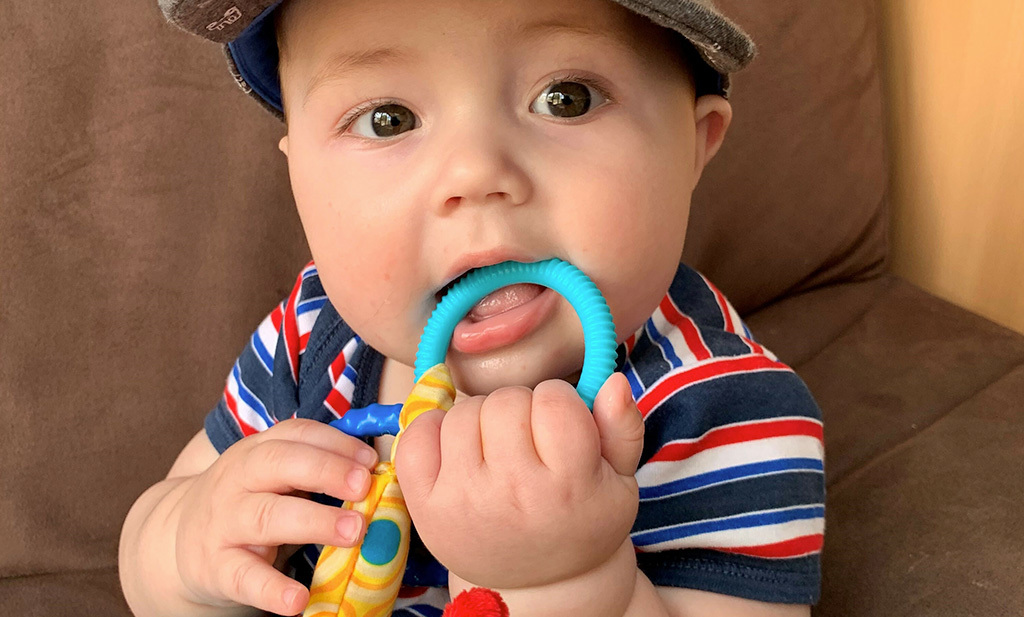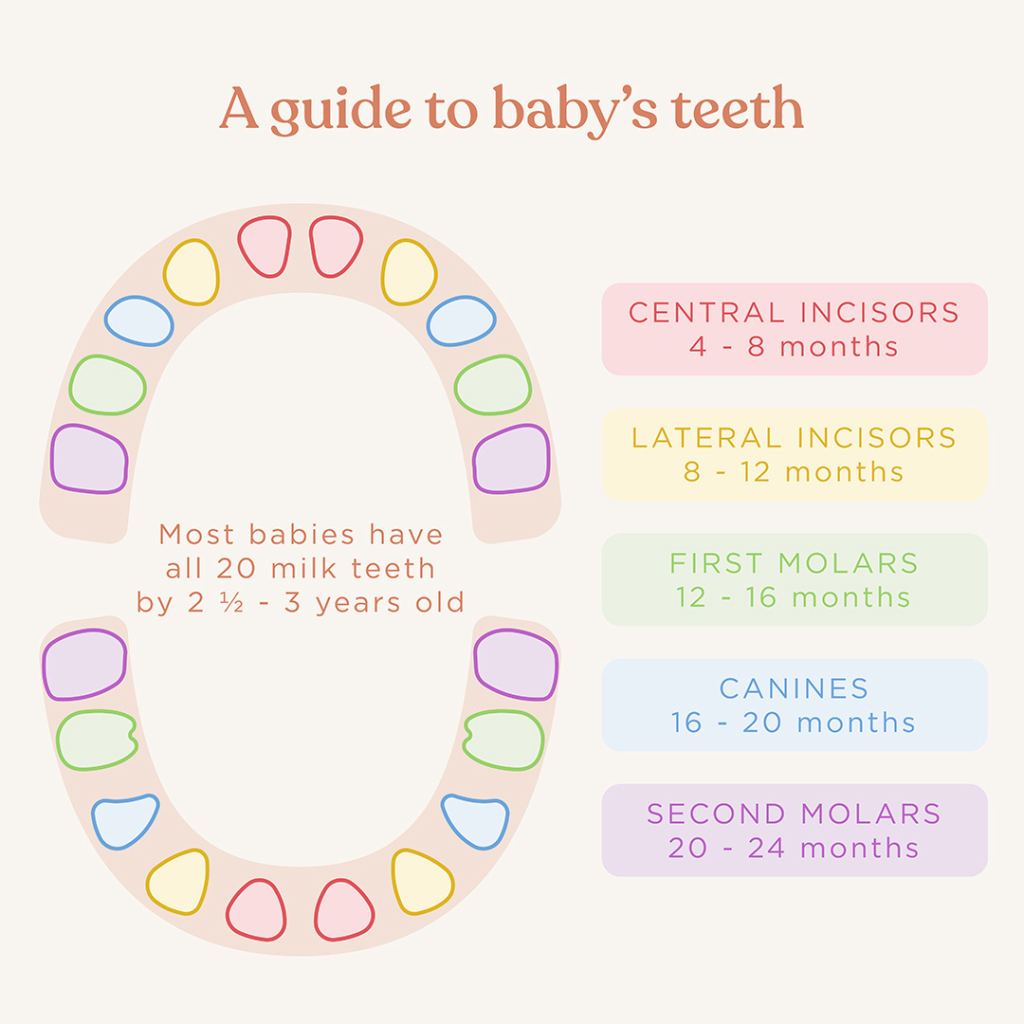
Has your baby been unhappy for days, crying a lot and drooling and chewing on everything in their path? Then a tooth is probably on the way. A really challenging time for your little darling, but also for you. Because the helplessness you experience as a parent during this time is simply awful. After all, you want to take away your little one’s pain or at least be there to sympathise with them. But how? “How to help a teething baby” is a universally searched-for phrase by parents – it might even be how you came to find this blog! And anyway: how do you even know that it’s the teeth that are tormenting your baby? After all, it is often the case that a baby is teething but there is no tooth in sight. Together with our midwife and babywearing expert Katrin Ritter, we take a look behind the scenes of teething and explain what’s going on in your baby’s jaw. So here they are, the most pressing questions (and answers) about teething babies.
The baby teething process: what to expect
Tooth emergence, also known as tooth eruption, is a complex process, the mechanisms of which are not yet fully understood. Both deciduous and permanent teeth are already laid down during pregnancy. At birth, the so-called crowns of the milk teeth (the visible part of the teeth) are already fully formed. Root formation, however, still takes some time and is completed between the ages of 1.5 – 3 years. All in all, baby teething is a long development process that can sometimes be painful or at least uncomfortable. This means that if your baby shows all the symptoms of teething (see below), but you wait in vain for something visible in the mouth, it could still be the teeth that are bothering your baby. This is followed by the eruption of teeth, which happens in several stages. This means that the teeth come to the surface of the gums one after the other. For many babies (but not all!) this step is the most painful.
When does a baby start teething?
Babies’ teeth are already laid down in the jawbone in the womb. On average, the first milk teeth erupt between the baby’s sixth and eighth month of life. But only on average. It is not uncommon for this to happen as early as the third or fourth month of life. Or only in the second year of life. Sometimes the first tooth is even there at birth. As you can see, as always, it’s very individual and the figures are just a guide. So don’t get stressed!
How many teeth does a baby have in total?
A child’s dentition consists of 20 milk teeth – ten in the upper jaw and ten in the lower jaw. These are a total of eight milk incisors, four milk canines and eight milk molars.
What order do the teeth come in?
In the following diagram you can see the order in which the milk teeth usually erupt. As already mentioned, the timing may vary, but not the order, you can read more about the order of teeth here. (link to teething blog)

Teething symptoms – how can I recognise it?
Some babies start to get cranky and clingy three to four days before their teeth actually erupt. Others don’t show any teething symptoms at all. But what they all have in common is that they put whatever they can get their hands on into their mouths. And babies also like to chew on these and drool. A lot. And this is completely normal, because in the first year of life your baby is in the oral phase (from psychology), in which the mouth is the centre of attention. This is where exploration takes place, pleasure is felt (sucking), food is ingested, and basic physical and sensual needs are satisfied. By fulfilling these needs, the child feels accepted and can develop basic trust. It is therefore of great value if you support this and also fulfil the need for physical closeness (e.g. with a baby carrier). To ensure that your baby gets through this phase of discovery and teething well, it is of course important to make sure that your little treasure does not come into contact with dangerous objects or substances. You should also pay attention to hygiene. However, it is sufficient to clean the objects of desire daily under running water.
The increased salivation can also cause skin irritation on the face – known as a teething rash. Sometimes the little ones also suffer from an increased temperature or diarrhoea. However, it is often said that there is no clear connection to teething, but simply an underlying infection. So please visit your GP if necessary. If your baby is restless during the day, the night will probably also be correspondingly bumpy. In addition, sensitive gums can lead to your baby having less appetite and refusing to eat.
What do the gums look like during baby teething?
In most cases, the baby’s gums are red and swollen and small bumps, or buds, can be seen. If you run a clean finger over them you will probably be able to feel the hard tooth underneath.

How long does a baby teeth per tooth?
Again, this is very individual. For some babies, root formation is already uncomfortable, for others it only becomes uncomfortable when the tooth actually erupts. On average, babies struggle with each tooth for three to four days. As the teeth usually come in one after the other, these periods can overlap.
How to help teething baby
You won’t be able to completely relieve your baby’s pain, but at least you can alleviate it a little. The following aids are suitable for this:
- Teething gel – Pharmacies and drugstores can provide you with a teething gel which is applied directly to the sore area in the mouth. They should numb the pain for just under an hour. The effect of dental gels has not been scientifically proven, but they certainly have a cooling effect. Please only use them after consulting a doctor or midwife.
- Teething toys – Chew toys such as teething rings are very popular because they provide distraction, and your baby can massage their gums with them. Some can be cooled in the fridge (never the freezer) in advance. Never tie teething toys around your baby’s neck, as it may be a choking hazard.
- Massage – Speaking of massage. You can gently massage your little one’s gums with a clean finger or a baby dental care finger stick (available in drugstores and pharmacies). This stimulates blood circulation and soothes the pain.
- Drinking – Feeding on demand can help.
- Moist flannel – Offer your baby a moist and cool flannel and place it on the sore area in the mouth or let your baby suck on it (please wash organic cotton flannels without detergent at 90 degrees beforehand). This also cools and feels good.
- Teething Powder – Ask at the pharmacy for certain homeopathic remedies such as a teething powder that is specially tailored to teething problems. Please discuss this with your midwife beforehand.
- Fever suppositories/painkillers – Do you have the feeling that your baby is not getting any rest due to being in pain? Then you can also give your baby paracetamol or ibuprofen (from 3 months). Speak to your GP or pharmacist if you’re unsure.
- Lots of love and closeness – Is your baby particularly clingy? Then give them the closeness they need these days. So that you still have your hands free, we recommend using a baby carrier.
Baby teething – now you know how to help teething baby
As you can see, there’s a lot going on in baby’s jaw and mouth for a while. And even if there is no sure-fire way of how to help teething baby, hopefully we have been able to give you a little more peace and serenity during this exhausting time. And now you also know that if your baby is teething but there is no tooth in sight, it could still be the teeth that are making themselves felt. It just takes a little while. Just be there for your baby, keep cool (literally), try massage and give lots of love. That way they won’t feel so alone when their first tooth (or the second, third fourth etc.) bothers them. By the way: you can find out what you should do when the first teeth appear here.



